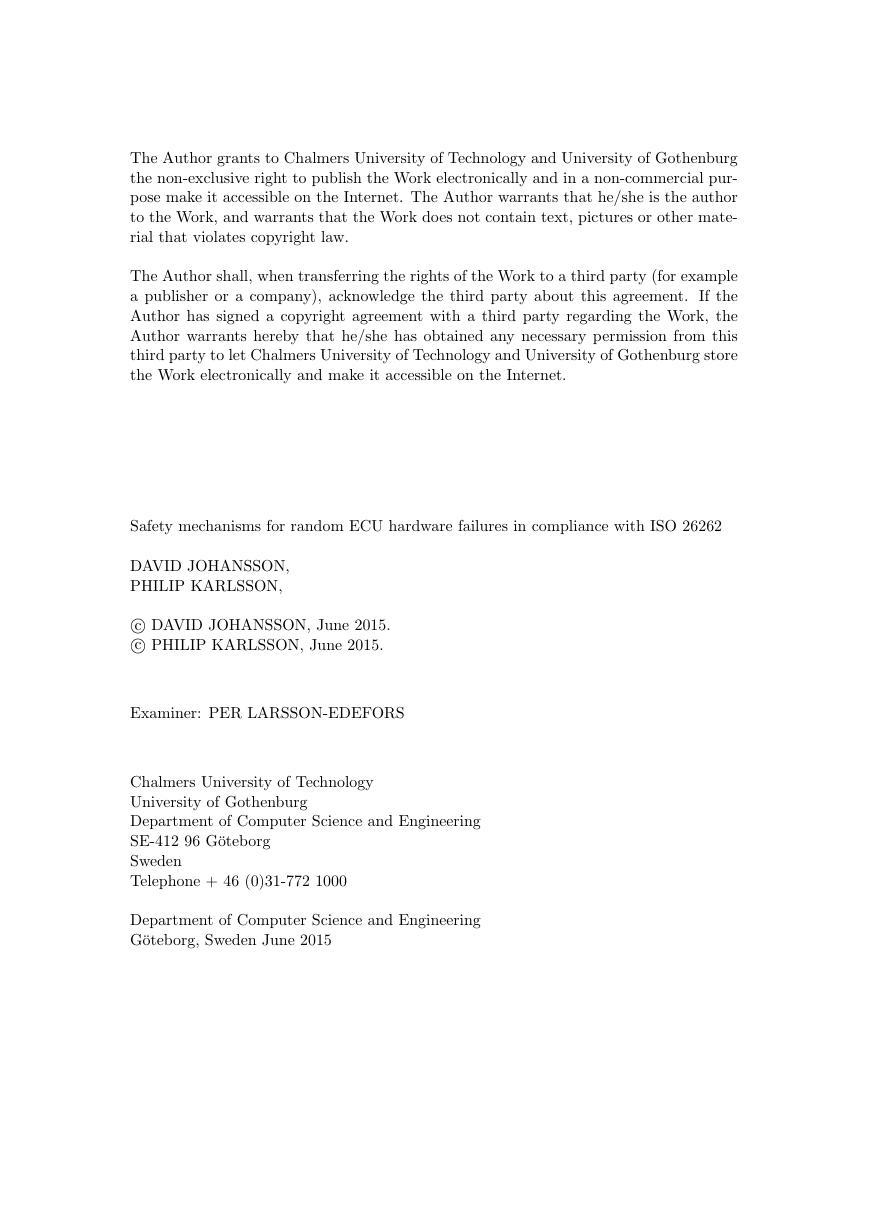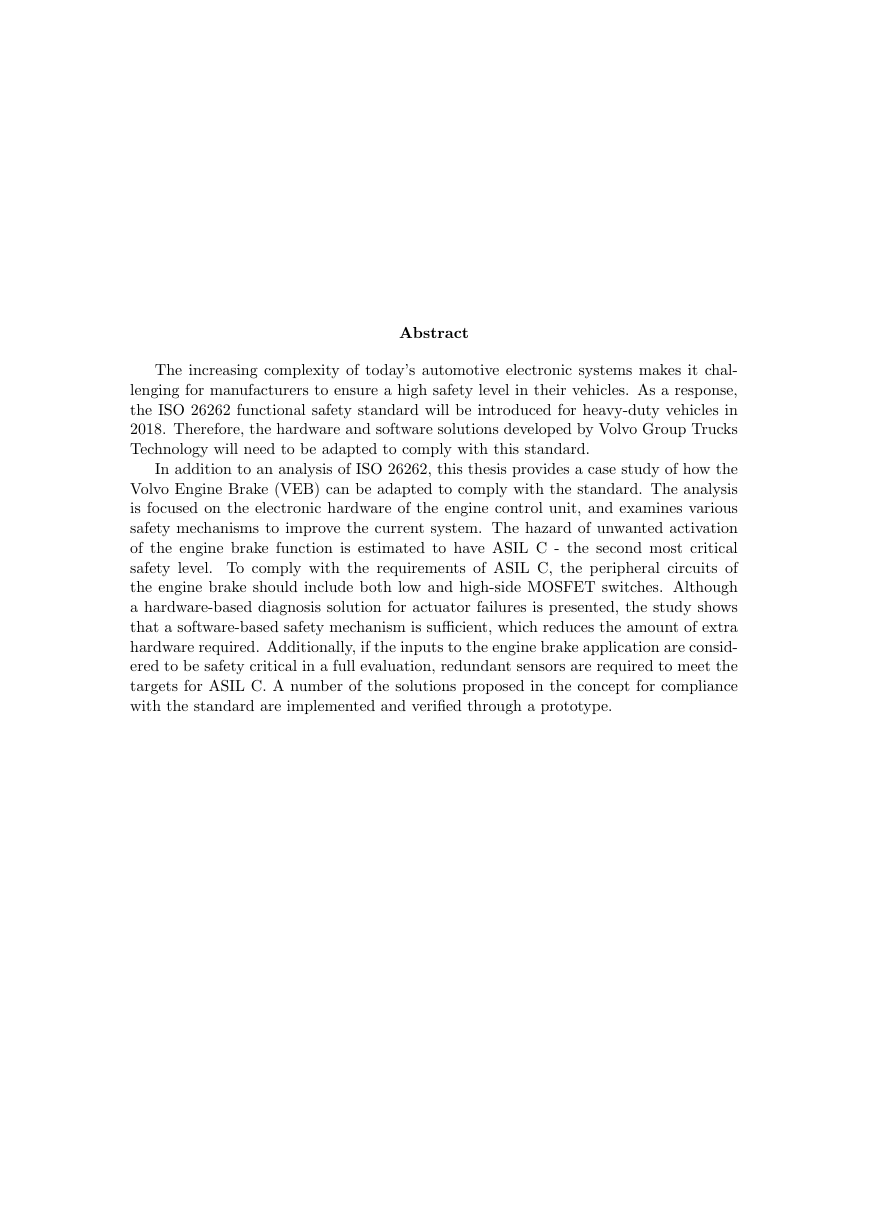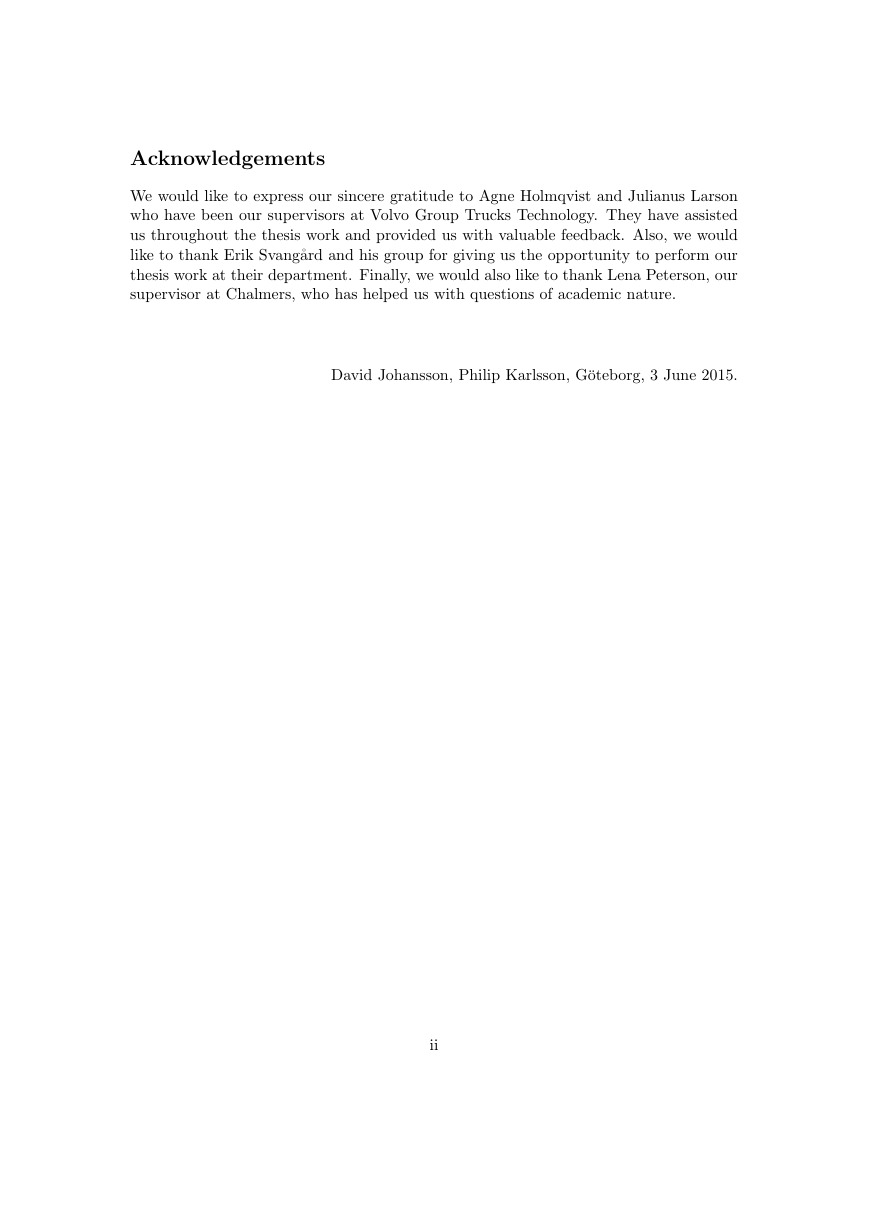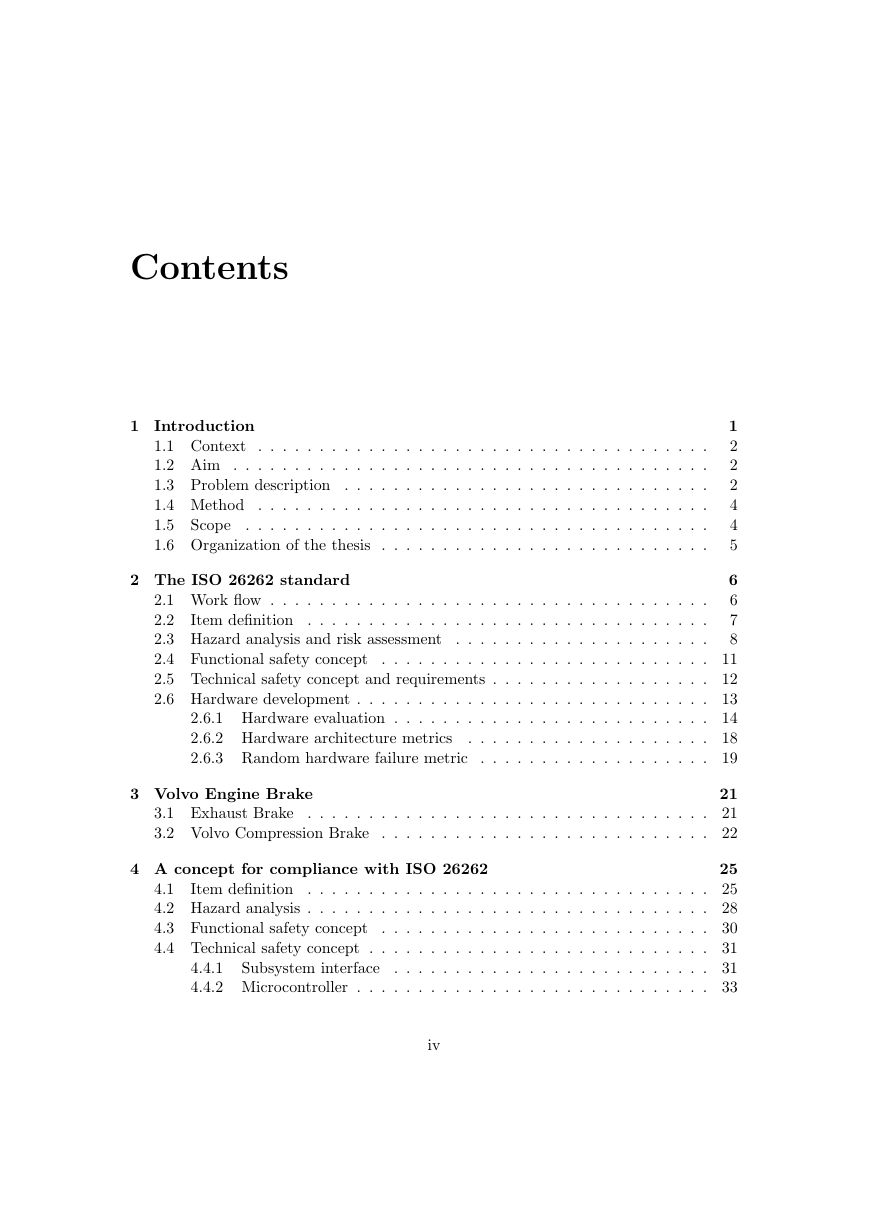Safety mechanisms for random ECU
hardware failures in compliance with
ISO 26262
Master of Science Thesis in Embedded Electronic System Design
DAVID JOHANSSON
PHILIP KARLSSON
Department of Computer Science and Engineering
Chalmers University of Technology
Gothenburg, Sweden June 2015
�
The Author grants to Chalmers University of Technology and University of Gothenburg
the non-exclusive right to publish the Work electronically and in a non-commercial pur-
pose make it accessible on the Internet. The Author warrants that he/she is the author
to the Work, and warrants that the Work does not contain text, pictures or other mate-
rial that violates copyright law.
The Author shall, when transferring the rights of the Work to a third party (for example
a publisher or a company), acknowledge the third party about this agreement. If the
Author has signed a copyright agreement with a third party regarding the Work, the
Author warrants hereby that he/she has obtained any necessary permission from this
third party to let Chalmers University of Technology and University of Gothenburg store
the Work electronically and make it accessible on the Internet.
Safety mechanisms for random ECU hardware failures in compliance with ISO 26262
DAVID JOHANSSON,
PHILIP KARLSSON,
c DAVID JOHANSSON, June 2015.
c PHILIP KARLSSON, June 2015.
Examiner: PER LARSSON-EDEFORS
Chalmers University of Technology
University of Gothenburg
Department of Computer Science and Engineering
SE-412 96 G¨oteborg
Sweden
Telephone + 46 (0)31-772 1000
Department of Computer Science and Engineering
G¨oteborg, Sweden June 2015
�
�
Abstract
The increasing complexity of today’s automotive electronic systems makes it chal-
lenging for manufacturers to ensure a high safety level in their vehicles. As a response,
the ISO 26262 functional safety standard will be introduced for heavy-duty vehicles in
2018. Therefore, the hardware and software solutions developed by Volvo Group Trucks
Technology will need to be adapted to comply with this standard.
In addition to an analysis of ISO 26262, this thesis provides a case study of how the
Volvo Engine Brake (VEB) can be adapted to comply with the standard. The analysis
is focused on the electronic hardware of the engine control unit, and examines various
safety mechanisms to improve the current system. The hazard of unwanted activation
of the engine brake function is estimated to have ASIL C - the second most critical
safety level. To comply with the requirements of ASIL C, the peripheral circuits of
the engine brake should include both low and high-side MOSFET switches. Although
a hardware-based diagnosis solution for actuator failures is presented, the study shows
that a software-based safety mechanism is sufficient, which reduces the amount of extra
hardware required. Additionally, if the inputs to the engine brake application are consid-
ered to be safety critical in a full evaluation, redundant sensors are required to meet the
targets for ASIL C. A number of the solutions proposed in the concept for compliance
with the standard are implemented and verified through a prototype.
�
i
�
Acknowledgements
We would like to express our sincere gratitude to Agne Holmqvist and Julianus Larson
who have been our supervisors at Volvo Group Trucks Technology. They have assisted
us throughout the thesis work and provided us with valuable feedback. Also, we would
like to thank Erik Svang˚ard and his group for giving us the opportunity to perform our
thesis work at their department. Finally, we would also like to thank Lena Peterson, our
supervisor at Chalmers, who has helped us with questions of academic nature.
David Johansson, Philip Karlsson, G¨oteborg, 3 June 2015.
ii
�
iii
�
Contents
1 Introduction
1.1 Context . . . . . . . . . . . . . . . . . . . . . . . . . . . . . . . . . . . . .
1.2 Aim . . . . . . . . . . . . . . . . . . . . . . . . . . . . . . . . . . . . . . .
1.3 Problem description . . . . . . . . . . . . . . . . . . . . . . . . . . . . . .
1.4 Method . . . . . . . . . . . . . . . . . . . . . . . . . . . . . . . . . . . . .
1.5 Scope
. . . . . . . . . . . . . . . . . . . . . . . . . . . . . . . . . . . . . .
1.6 Organization of the thesis . . . . . . . . . . . . . . . . . . . . . . . . . . .
1
2
2
2
4
4
5
2 The ISO 26262 standard
6
6
2.1 Work flow . . . . . . . . . . . . . . . . . . . . . . . . . . . . . . . . . . . .
7
2.2
Item definition . . . . . . . . . . . . . . . . . . . . . . . . . . . . . . . . .
8
2.3 Hazard analysis and risk assessment
. . . . . . . . . . . . . . . . . . . . .
2.4 Functional safety concept
. . . . . . . . . . . . . . . . . . . . . . . . . . . 11
2.5 Technical safety concept and requirements . . . . . . . . . . . . . . . . . . 12
2.6 Hardware development . . . . . . . . . . . . . . . . . . . . . . . . . . . . . 13
2.6.1 Hardware evaluation . . . . . . . . . . . . . . . . . . . . . . . . . . 14
2.6.2 Hardware architecture metrics
. . . . . . . . . . . . . . . . . . . . 18
2.6.3 Random hardware failure metric . . . . . . . . . . . . . . . . . . . 19
3 Volvo Engine Brake
21
3.1 Exhaust Brake . . . . . . . . . . . . . . . . . . . . . . . . . . . . . . . . . 21
3.2 Volvo Compression Brake . . . . . . . . . . . . . . . . . . . . . . . . . . . 22
4 A concept for compliance with ISO 26262
25
4.1
Item definition . . . . . . . . . . . . . . . . . . . . . . . . . . . . . . . . . 25
4.2 Hazard analysis . . . . . . . . . . . . . . . . . . . . . . . . . . . . . . . . . 28
4.3 Functional safety concept
. . . . . . . . . . . . . . . . . . . . . . . . . . . 30
4.4 Technical safety concept . . . . . . . . . . . . . . . . . . . . . . . . . . . . 31
4.4.1
Subsystem interface . . . . . . . . . . . . . . . . . . . . . . . . . . 31
4.4.2 Microcontroller . . . . . . . . . . . . . . . . . . . . . . . . . . . . . 33
iv
�
















 2023年江西萍乡中考道德与法治真题及答案.doc
2023年江西萍乡中考道德与法治真题及答案.doc 2012年重庆南川中考生物真题及答案.doc
2012年重庆南川中考生物真题及答案.doc 2013年江西师范大学地理学综合及文艺理论基础考研真题.doc
2013年江西师范大学地理学综合及文艺理论基础考研真题.doc 2020年四川甘孜小升初语文真题及答案I卷.doc
2020年四川甘孜小升初语文真题及答案I卷.doc 2020年注册岩土工程师专业基础考试真题及答案.doc
2020年注册岩土工程师专业基础考试真题及答案.doc 2023-2024学年福建省厦门市九年级上学期数学月考试题及答案.doc
2023-2024学年福建省厦门市九年级上学期数学月考试题及答案.doc 2021-2022学年辽宁省沈阳市大东区九年级上学期语文期末试题及答案.doc
2021-2022学年辽宁省沈阳市大东区九年级上学期语文期末试题及答案.doc 2022-2023学年北京东城区初三第一学期物理期末试卷及答案.doc
2022-2023学年北京东城区初三第一学期物理期末试卷及答案.doc 2018上半年江西教师资格初中地理学科知识与教学能力真题及答案.doc
2018上半年江西教师资格初中地理学科知识与教学能力真题及答案.doc 2012年河北国家公务员申论考试真题及答案-省级.doc
2012年河北国家公务员申论考试真题及答案-省级.doc 2020-2021学年江苏省扬州市江都区邵樊片九年级上学期数学第一次质量检测试题及答案.doc
2020-2021学年江苏省扬州市江都区邵樊片九年级上学期数学第一次质量检测试题及答案.doc 2022下半年黑龙江教师资格证中学综合素质真题及答案.doc
2022下半年黑龙江教师资格证中学综合素质真题及答案.doc